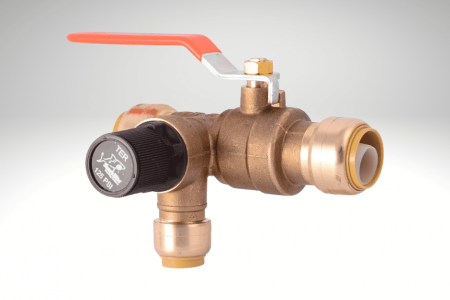Because of the way that modern plumbing is done, it’s often necessary to install relief measures to accommodate expanding water. Two of the most common ways to compensate for water expansion are thermal expansion relief valves and expansion tanks.
Thermal expansion relief valves and expansion tanks offer an outlet for steam and air when hot water heats up. While they perform the same function, they do it differently. If your plumbing system is a closed-loop system, you must have either a thermal expansion relief valve or an expansion tank above your water heater.
In this article, we’re going to compare these two relief options so that you can decide which one is right for your home. We’ll look at how each of them works and helps you get to the bottom of your water expansion problems.
Is an Expansion valve the same as an expansion tank?
Expansion valves and expansion tanks have the same job, but they look and perform differently from one another. An expansion tank looks like a small propane tank for a gas grill and gets installed directly above your water heater. When water heats up inside the water heater, it expands thanks to the steam it produces.
In open-loop plumbing systems, water expansion wasn’t a problem. Extra water would backflow down the water pipes and back into the city water supply. However, newer homes and communities require check valves to be installed in the plumbing system. Check valves keep water from flowing backward, which means that it’s a closed-loop system.
Because water is essentially trapped within the plumbing pipes inside your home, there has to be accommodation for water expansion. That’s where the expansion valve or expansion tank comes into play. Expansion tanks are installed directly above your water heater so that when water expands, the extra moisture and steam leaks into the expansion tank.
Expansion valves are installed in the same place as an expansion tank, but it relieves the plumbing system differently.
What does a thermal expansion relief valve do?
Thermal expansion relief valves open and close in order to relieve water pressure in a closed-loop plumbing system. The most significant difference between thermal relief valves and expansion tanks is how they relieve pressure. Rather than storing up the extra water created by heat, relief valves open and release the water.
Wondering how to check the pressure on your expansion tank? Read this article to find out.
Thermal expansion relief valves shouldn’t be confused with other types of relief valves. They’re designed to release extra water from plumbing systems rather than regulate it. Here are a few of the most common types of ‘relief valves.’
- Thermal Expansion Valve or TXV
This type of valve is used on air conditioners, and heat pumps to regulate the flow of refrigerants. It sounds similar to thermal expansion relief valves, but the purpose is entirely different.
- Fast Pressure Relief Valve
Fast pressure relief valves could theoretically be used on plumbing systems. They’re designed to release steam created by water expansion into the air. However, they’re most commonly used commercially in nuclear plants and similar operations.
- Thermal Expansion Relief Valve
Thermal expansion relief valves are the valves that we’re focusing on in this article. They’re installed in closed-loop plumbing systems to release extra water created by heat expansion.
- Water Heater Pressure Relief Valve
Water heater pressure relief valves are the valves that are standard on the outside of water heaters. However, these relief valves are unreliable, and I’ve witnessed first-hand what happens when you entrust them with thermal expansion. They often fail to open up and are meant as a last defense against thermal expansion rather than the primary one.
Thermal expansion relief valves are the future of the plumbing world. They’re less bulky and obtrusive than tanks and easier to install. They’re also approved for plumbing use in most parts of the country.
Shark bite thermal expansion relief valve
SharkBite is one of the most popular names in the plumbing industry. They’re leading the way in thermal expansion relief valves and are beloved for their reliable and easy-to-install products. Thermal expansion relief valves from SharkBite are quickly becoming a popular alternative to expansion tanks, and here’s why.
Advantages of SharkBite thermal expansion relief valves over expansion tanks
- Less bulky than expansion tanks
Thermal expansion relief valves are small and nondescript compared to bulky expansion tanks. They consist of a single ball valve installed on the cold water line before the water heater.
- Easier to install than expansion tanks
Installing an expansion tank often requires the skills of a professional plumber. On the other hand, thermal expansion relief valves from SharkBite can be installed by anyone. They’re compatible with pex, copper, CPVC, and most other plumbing pipes.
- Easier to maintain than expansion tanks
Expansion tanks are prone to pinhole leaks, faulty components, and condensation. Thermal expansion relief valves have none of these issues when properly installed. They also require very little ongoing maintenance.
- No soldering is required
Anytime you’re working with expansion tanks, they often have to be supported by copper pipe since they get heavy when they fill with water. This means soldering, which is extremely difficult if you don’t have the equipment and experience necessary. SharkBite expansion valves are much easier to install and require no soldering.
- Cheaper to install than expansion tanks
Finally, thermal expansion relief valves are cheaper to install than expansion tanks. This is because they cost less to purchase and take less time to install.
Do I need a thermal expansion tank with well water?
Whether you have well water, city water, or any other type of water, thermal expansion tanks or relief valves are required in closed-loop systems. The only time you don’t need a relieving device for your water is in an open-loop plumbing system.
Final Thoughts
Well, there you have it, everything you need to know about the innovative thermal expansion relief valve. These valves can save you big bucks compared to bulky and expensive expansion tanks. They can also save you water damage and water heater problems if you have a closed-loop plumbing system. If you’re ready to take the next step in your plumbing system, consider installing a thermal expansion relief valve in place of your expansion tank.
References

Nick Lopresti is the founder of YourH2Home and a home improvement expert. He has years of experience writing about various home improvement topics, mostly as it pertains to water systems.
